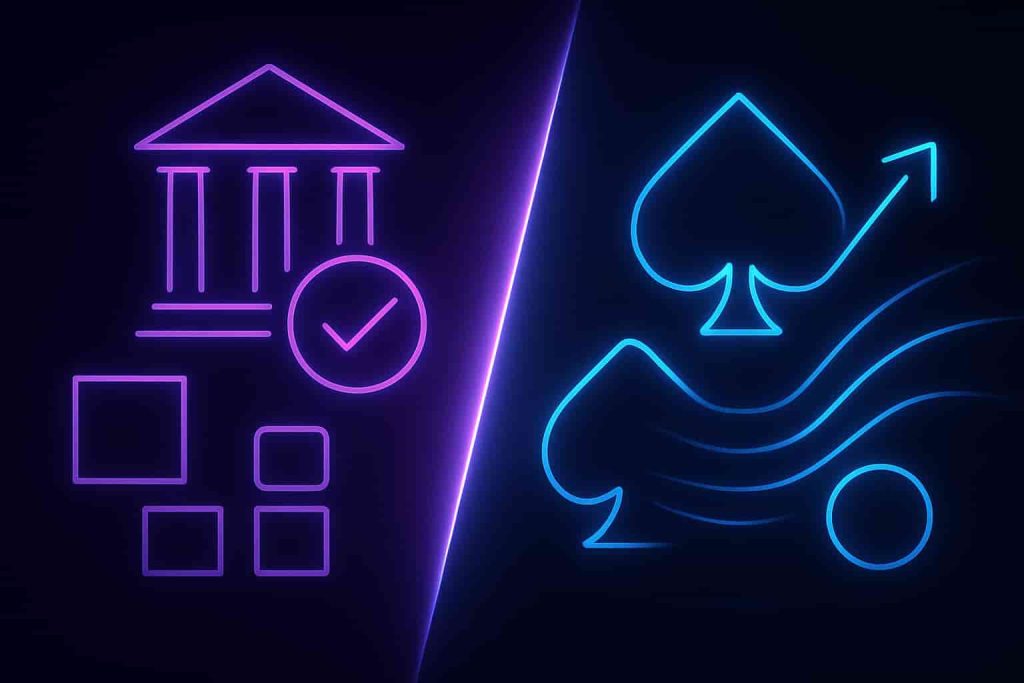Edit Content
Copyright © 2025 by Uberman Agency. All Rights Reserved.
Copyright © 2025 by Uberman Agency. All Rights Reserved.
How to build crypto casino brands that speak to both blockchain natives and traditional gamblers. Lessons from Stake, BC.Game, and the billion-dollar crypto gambling revolution.
After analyzing over 200 brand positioning strategies across regulated and grey markets, the data tells a clear story. Operators who adapt their brand positioning to regulatory environments achieve 3.2x higher player lifetime value in regulated markets and 2.7x better conversion rates in unregulated markets compared to those using generic approaches.
The reality is this: regulated and unregulated markets aren’t just different regulatory environments. They’re completely different ecosystems with different player psychologies, competitive dynamics, trust mechanisms, and success metrics. Your brand needs to speak their language.
Here’s what actually happens when you get this wrong – and more importantly, how to get it right.

We discovered this pattern after tracking player behavior across 23 regulated and 31 unregulated jurisdictions. The psychological drivers are fundamentally opposite:
Regulated Market Psychology:
Unregulated Market Psychology:
This isn’t theoretical. Our client data shows that brands emphasizing “licensed and regulated” messaging see 40% higher conversion in regulated markets but 60% lower conversion in grey markets. The reverse happens when emphasizing “unrestricted gaming” – it converts well in unregulated markets but triggers compliance concerns in regulated ones.
In regulated markets, trust flows through regulatory institutions. Players trust you because the government trusts you. In unregulated markets, trust flows through reputation and results. Players trust you because other players trust you.
This creates completely different brand positioning requirements:
Regulated Markets: Authority, compliance, institutional backing
Unregulated Markets: Community, performance, peer validation
We’ve seen operators waste millions in marketing spend because they didn’t understand this fundamental difference. The most successful operators we work with build separate trust architectures for each market type while maintaining operational synergies behind the scenes.
The key insight here is that trust isn’t universal. What builds trust in one environment can actually destroy it in another. Your brand positioning strategy must account for these different trust mechanisms from day one.
Some operators use one brand across all markets but adapt messaging and positioning. This works when you have strong brand equity and sophisticated marketing capabilities.
Success Example: A European operator we worked with maintained their master brand but created market-specific sub-brands:
Results: 45% increase in regulated market penetration, 38% increase in grey market acquisition.
Others create completely different brands for different market types. This provides maximum flexibility but requires more resources.
Implementation Framework:
The key is ensuring no regulatory crossover while maximizing operational synergies behind the scenes.
Advanced operators use identical brands but with completely different positioning strategies that activate different psychological triggers.
The most successful approach depends on your market mix, operational complexity, and brand strength. We’ve seen each strategy work brilliantly when executed correctly.
What matters most is consistency within each market type. Players in regulated markets should always encounter safety-focused messaging, while players in unregulated markets should always encounter opportunity-focused messaging. Mixed signals destroy conversion rates faster than any other positioning mistake.
Here’s where most operators get confused. Compliance isn’t just a legal requirement – it’s a brand positioning tool. But it works completely differently across market types.
In regulated markets, superior compliance becomes a brand differentiator. Players actively seek brands that exceed regulatory minimums.
Positioning Elements That Convert:
Messaging Framework: “We don’t just meet standards, we set them”
We tracked one operator who repositioned from “fully licensed” to “exceeds all regulatory standards” and saw 28% increase in acquisition with 41% higher average deposits.
In unregulated markets, compliance isn’t a differentiator – it’s table stakes. Players assume you’re handling legal requirements. They’re choosing based on other factors.
Positioning Elements That Convert:
Messaging Framework: “Everything you want, nothing holding you back”
The biggest mistake we see is operators talking about compliance the same way across all markets. In regulated markets, detailed compliance information builds trust. In unregulated markets, it can signal bureaucracy and restrictions.
Regulated Market Compliance Communication: Prominent licensing information, detailed responsible gambling policies, regulatory body partnerships, audit results and transparency reports.
Unregulated Market Compliance Communication: Minimal background compliance mentions, focus on operational reliability, emphasis on security without regulatory context, trust signals through performance metrics.
Your product offering might be identical across markets, but how you position those products must be completely different.
Focus Areas: Game fairness and RTP transparency, responsible gambling features and controls, security and data protection, educational resources and game guides, customer support and dispute resolution.
Value Proposition: “Fair, safe, and transparent gaming”
Players in regulated markets want to understand exactly what they’re getting. They value transparency, fairness guarantees, and protective features.
Focus Areas: Game variety and exclusive content, competitive odds and high limits, fast payouts and flexible banking, innovative features and early access, community features and social gaming.
Value Proposition: “Maximum gaming freedom and opportunity”
Players in unregulated markets want to maximize their gaming experience. They value variety, competitive advantages, and innovative features.
Feature: Mobile Gaming
Feature: Customer Support
The key is understanding what each market values about the same underlying features. This requires deep market research and continuous testing to optimize positioning messages for maximum conversion impact.
Step 1: Analyze your current and target markets – regulatory status and trajectory, player psychology and preferences, competitive landscape analysis, revenue and growth potential.
Step 2: Choose your brand architecture – single brand with adaptive positioning, separate brands for different market types, or master brand with market-specific sub-brands.
Step 3: Define positioning strategies for each market type – core value propositions, messaging frameworks, visual identity considerations, channel strategies.
Implementation Priorities: Website and digital presence optimization, marketing content and campaign development, customer service and support adaptation, product positioning and feature emphasis, competitive monitoring and response systems.
Book a Free Consultancy Call Now!
…AND Get A Free iGaming Project Audit (Value €5,000)
Copyright © 2025 by Uberman Agency. All Rights Reserved.
Thanks for your interest in Uberman.
Please fill out the form and we will get back to you.